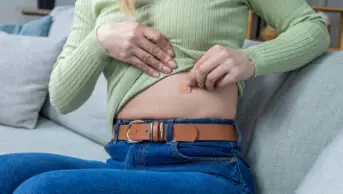
IRATXE LÓPEZ DE MUNÁIN
While menopause is a natural change that marks the end of a female’s reproductive capacities, its symptoms can come down like a supernatural hammer. Sudden hot flushes, night sweats, insomnia, fatigue and brain fog descend on women, and while many can muddle through these changes, others experience symptoms so intense that they disrupt work and daily activities.
These symptoms can create a domino effect that eventually undermines a woman’s confidence in herself
Kathy Abernethy, director of menopause services at digital health app Peppy, and former chair of the British Menopause Society
“These symptoms can create a domino effect that eventually undermines a woman’s confidence in herself,” says Kathy Abernethy, director of menopause services at digital health app Peppy, and former chair of the British Menopause Society.
For example, where night sweats and insomnia can result in memory problems and disorganisation during the day, hot flushes during the day may spur embarrassment and anxiety — adding a sleep deficit to the mix could lead to depression.
The menopause leaves many women bewildered and wanting a way to manage their symptoms. Hormone replacement therapy (HRT) is the first line of treatment, but it is contraindicated for some and shunned by many owing to concerns about increased risk of cancer and heart disease. Though this risk may be minimal for managing menopause symptoms in the short term, the concern is widespread enough that many women will forgo HRT, opting instead for less effective non-medical or non-hormonal options.
However, the range of treatment choices may soon increase. A new class of drugs is in clinical trials — neurokinin 3 receptor (NK3R) antagonists, which act on the brain’s thermoregulatory centres to modulate hot flushes and night sweats. One drug, fezolinetant (Astellas Pharma), has been accumulating positive results in phase III clinical trials, while two others — osanetant and elinzanetant — are in earlier stages of testing.
This new drug class could be a saviour to women with hot flushes and night sweats because these vasomotor symptoms are considered to be the most bothersome of menopause. These drugs, combined with increased awareness about the impacts of menopause in the workplace and updated National Institute for Health and Care Excellence (NICE) guidelines, which will incorporate new evidence for managing hot flushes, promise new approaches for supporting women in menopause.
“Menopause management should be personalised,” Abernethy says. “We need more options so that women can make a personal choice.”
Hot flush burden
As women age, natural declines in oestrogen produced by the ovaries bring child-bearing to an end and initiate menopause symptoms. A hot flush, one of the more characteristic vasomotor symptoms of menopause, is marked by a sudden, intense sensation of heat lasting for one to five minutes, which triggers sweating and skin vasodilation.
Most women experience vasomotor symptoms, such as hot flushes, night sweats and heart palpitations, to some degree, with an estimated 57% of women aged 40–64 years globally reporting hot flushes and sweating[1]. In the UK, at least half of women in midlife (aged 45–54 years) report experiencing hot flushes and these symptoms can linger, lasting seven years or longer, which can translate into impairments in quality of life[2–6].
For some women, hot flushes are a minor annoyance and occur less than once per day. Others, however, can go through eight or more intense episodes per day — enough to drive them to seek treatment. Published in June 2022, a survey of more than 1 million electronic records in the UK found that, each year, 21% of women aged 40–65 years had sought help for their vasomotor symptoms from their GP[7].
A fifth of women in that age group is quite a lot of burden
Lynne Robinson, a consultant gynecologist at Birmingham Women’s Hospital, who also leads a menopause service
“A fifth of women in that age group is quite a lot of burden,” says Lynne Robinson, a consultant gynaecologist at Birmingham Women’s Hospital, who also leads a menopause service. Robinson also collaborated in the study with researchers at Astellas Pharma, which is developing fezolinetant, one of the NK3R antagonists in clinical trials.
Similarly, NICE estimates around 1 million women in the UK seek to treat their menopause symptoms[8].
Finding the right treatment
Choosing a treatment path for these symptoms is complicated, though potentially more than it needs to be.
HRT is the first line of treatment. Taken orally or transdermally, it provides additional oestrogen or oestrogen in combination with progesterone. This deals effectively with common symptoms of menopause, including vasomotor symptoms, and has the side benefit of preventing osteoporosis[9].
Yet many women are wary about HRT. Women with hormone-sensitive cancers are rightly contraindicated from taking HRT, whereas others remain spooked by the results of two large trials published 20 years ago that showed an association between HRT and an increased risk of breast cancer and cardiovascular disease[10,11].
Today many experts argue that these risks are overblown and do not apply to all women equally. For example, a re-analysis of the data from one of the studies did not find these increased risks when it took into account confounding factors, such as age, obesity and smoking[12]. Overall, the risks of cancer or cardiovascular events increase for women aged over 60 years who take HRT much more than for those in their 50s[13,14]. When a 2019 study still found an increased risk for breast cancer in women who take HRT for over a one-year period, some argued that the degree of risk is less than that owing to common factors like alcohol use or obesity[15,16].
Prescribers need to consider the individualised profile of a patient’s risk factors
Nuttan Tanna, a consultant pharmacist in women’s health at Northwick Park Hospital in Harrow, London
“HRT use is a nuanced decision,” says Nuttan Tanna, a consultant pharmacist in women’s health at Northwick Park Hospital in Harrow, London. “Prescribers need to consider the individualised profile of a patient’s risk factors.”
However, the impression that HRT is dangerous has been hard to shake. “Overcoming the misinformation out there about HRT is like turning a giant trawler,” Abernethy says.
NICE guidelines on HRT have had to keep up with changing data. In 2015, NICE revised its guidance to reflect that HRT could reduce menopause symptoms safely in certain women[17]. However, after the 2019 study associating HRT to breast cancer, NICE amended its guidance to outline how risk varied with HRT type, dose and length of use[18]. Newer studies have compelled NICE to begin updating its guidance once again. The review will include an examination of the evidence for cognitive behavioral therapy as a means to reduce distress related to hot flushes, as well as looking at the long-term effects of HRT on several conditions, including breast cancer, dementia, osteoporosis and coronary heart disease. The updated guidance is due to come out in 2023[19].
Non-hormonal options
Beyond HRT, there are several non-hormonal options for women who do not want or cannot take HRT, such as those with oestrogen-sensitive disease like breast or endometrial cancer. Tanna and colleagues have developed prescribing guidance for women with breast cancer who are struggling with menopause symptoms[20].
However, the effect sizes are modest and side effects common. Low doses of selective serotonin reuptake inhibitors (SSRIs) and serotonin noradrenaline reuptake inhibitors (SNRIs) may produce adverse effects, such as nausea, reduced libido or suicidal thoughts. The anti-seizure drug gabapentin can come with drowsiness or dizziness. Similarly, a low dose of clonidine has side effects, such as headache, dry mouth and difficulty with sleep (see Box)[21,22].
Box: Current recommended non-hormonal management of hot flushes in the UK[22]
Consider a trial of:
- Selective serotonin reuptake inhibitors (SSRIs, off-label) or serotonin and norepinephrine reuptake inhibitors (SNRIs, off-label) for two weeks initially.
- Options include fluoxetine (20mg daily), citalopram (20mg daily), paroxetine (10mg daily), or venlafaxine modified-release (37.5mg daily for one week then increased to 75mg once daily if needed).
- Clonidine (an alpha-2 adrenergic receptor agonist).
- Initially 50 micrograms twice daily for two weeks, then increased to 75 micrograms twice daily, if needed.
- Gabapentin (off-label), depending on local prescribing guidelines.
- Up to 300mg three times per day, initial dose should be lower and titrated up over three days.
- Cognitive behavioural therapy, depending on local service provision.
The NK3R antagonists currently in clinical trials may soon offer useful options to women who cannot or will not take HRT, those who struggle with side effects from other non-hormonal treatments and those who were denied HRT in the past owing to perceived risks. So far, seven studies have been published on three NK3R antagonists.
“There is a clear unmet need for women,” says Marci English, global development project leader at Astellas Pharma, developer of fezolinetant.
The NK3R antagonists act within the brain’s thermoregulatory pathways, which have only been clarified in the past decade. Research in rodents first found that neurones in the hypothalamus, called KNDy (or ‘candy’) neurones, instigated hot flushes[23,24]. KNDy neurons produce and release neuropeptides, including one called neurokinin B. Normally, when KNDy neurones fire, they release neurokinin B onto neurones in the medial preoptic nucleus (MnPO), which have NK3 receptors on their surface. This triggers a heat dissipation response, involving sweating and skin vasodilation that then reduces body core temperature. Neurokinin B infusions into premenopausal women induce hot flushes[25].
During menopause, this circuit becomes overly sensitive: as oestrogen levels decline, KNDy neurones grow larger and become overactive. This leads to inappropriate activation of MnPO neurones, and triggers hot flushes (see Figure).
The new NK3R antagonists in clinical trials dampen communication between the overactive KNDy neurones and the MnPO. “It restores the homeostasis,” says English.
Fezolinetant has been tested in three phase III randomised clinical trials, all with positive results involving significant reductions in hot flush frequency and severity compared with placebo.
Fezolinetant’s most recent results come from the SKYLIGHT 2 trial, which was presented at ENDO 2022, the Endocrine Society’s annual meeting in Atlanta, Georgia, in June 2022[26,27]. This trial enrolled 501 women aged 40–65 years, who reported an average of at least seven to eight hot flushes a day. A daily dose of fezolinetant appears to show a reduction in vasomotor symptom frequency of around two hot flushes per day, as well as a reduction in symptom severity compared with placebo at 4 weeks and 12 weeks. This reduction was maintained at 52 weeks during an extension period and was also observed among those who originally showed a placebo response. Fezolinetant, which has a rapid onset of action, was also associated with improved sleep and seemed well tolerated.
The most common adverse event was headaches, which do not compel participants to drop out of the study. These results and others, including those of SKYLIGHT 4 — a long-term safety study of fezolinetant — spurred Astellas Pharma to submit a new drug application to the US Food and Drug Administration in June 2022[28,29].
I’m so excited to think that this drug is going to help women, who I think, up until now, suffer a little bit in silence
Marci English, global development project leader at Astellas Pharma
“I’m so excited to think that this drug is going to help women, who I think, up until now, suffer a little bit in silence,” English says.
In an earlier phase IIb trial, fezolinetant did not show any concerning elevations in liver enzymes[30]. This same problem shut down development of pavinetant, the first NK3R antagonist to be trialled in humans, the results of which were published in 2017[31]. Though pavinetant was effective in reducing vasomotor symptoms and was well tolerated, the associated changes in liver enzymes seen in a few women were concerning enough to discontinue its development[32]. The effect on liver function is thought to be specific to the molecular structure of pavinetant, rather than a general feature of the NK3R antagonist drug class[33].
The other NK3R antagonists under development are Acer Therapeutics’ osanetant, which is in phase II trials, and Bayer’s elinzanetant, a dual neurokinin 1 and 3 receptor antagonist currently being tested in multiple phase III trials[34–37].
Other treatment options
The hunt for non-hormonal treatments does not stop with NK3R antagonists. Current clinical trials include interventions as varied as stellate ganglion blocks, a vegan diet and nitroglycerin[38–40]. With the increased pace of investigation, some researchers have come together to recommend standardised outcome measures for vasomotor symptoms to make it easier to compare results[41]. They agreed that core measures should consist of hot flush frequency, severity, distress, effects on sleep, treatment satisfaction and side effects.
Task forces are also looking to support menopausal women in the workplace. NHS England pledged in June 2022 to help inform and support women going through menopause at work and, in July 2022, the UK government issued its own recommendations, including suggestions for employers and healthcare services[42,43]. Menopause-specific health services and some digital apps also offer specialised information and consideration for women going through the menopause.
While the new drugs await approval, Robinson says increased awareness among medical professionals can improve the support women receive while trying new treatments. For example, her study found that women tended to quit their medication after only four months, which she suspects is owing to side effects, which are often temporary.
We could support women better if we try and see if we can keep them persisting with it
Lynne Robinson, a consultant gynaecologist at Birmingham Women’s Hospital, who also leads a menopause service
“Women stop the treatment a little bit too soon, and don’t give it enough time for those initial side effects to disappear,” she says. “We could support women better if we try and see if we can keep them persisting with it.”
Other support may come from women themselves. Tanna suggests that a mindset of acceptance surrounding ageing and menopause may help reduce the distress of hot flushes.
“The thinking is that if you’re calm when you go through the menopause, if you accept it as the natural end of your reproductive phase, then it is better for you.”
- 1Makara-Studzińśka MT, Kryś-Noszczyk KM, Jakiel G. Epidemiology of the symptoms of menopause – an intercontinental review. pm. 2014;3:203–11. doi:10.5114/pm.2014.43827
- 2Duffy OK, Iversen L, Hannaford PC. Factors associated with reporting classic menopausal symptoms differ. Climacteric. 2012;16:240–51. doi:10.3109/13697137.2012.697227
- 3Mishra GD, Kuh D. Health symptoms during midlife in relation to menopausal transition: British prospective cohort study. BMJ. 2012;344:e402–e402. doi:10.1136/bmj.e402
- 4Avis NE, Crawford SL, Greendale G, et al. Duration of Menopausal Vasomotor Symptoms Over the Menopause Transition. JAMA Intern Med. 2015;175:531. doi:10.1001/jamainternmed.2014.8063
- 5Hunter M, Gentry-Maharaj A, Ryan A, et al. Prevalence, frequency and problem rating of hot flushes persist in older postmenopausal women: impact of age, body mass index, hysterectomy, hormone therapy use, lifestyle and mood in a cross-sectional cohort study of 10 418 British women aged 54-65. BJOG: An International Journal of Obstetrics & Gynaecology. 2011;119:40–50. doi:10.1111/j.1471-0528.2011.03166.x
- 6Williams RE, Levine KB, Kalilani L, et al. Menopause-specific questionnaire assessment in US population-based study shows negative impact on health-related quality of life. Maturitas. 2009;62:153–9. doi:10.1016/j.maturitas.2008.12.006
- 7Kiran A, Schultz NM, Siddiqui E, et al. Epidemiology and treatment patterns of UK women diagnosed with vasomotor symptoms: Findings from the Clinical Practice Research Datalink GOLD database. Maturitas. 2022;164:1–8. doi:10.1016/j.maturitas.2022.05.013
- 8Menopause: diagnosis and management — Context. National Institute for Health and Care Excellence. 2015.https://www.nice.org.uk/guidance/ng23/chapter/Context (accessed Nov 2022).
- 9Menopause: diagnosis and management — The challenge: communicating the long-term benefits and risks of hormone replacement therapy. National Institute of Health and Care Excellence. 2015.https://www.nice.org.uk/guidance/ng23/chapter/Menopause-implementation-getting-started#the-challenge-communicating-the-long-term-benefits-and-risks-of-hormone-replacement-therapy (accessed Nov 2022).
- 10Writing Group for the Women’s Health Initiative Investigators. Risks and Benefits of Estrogen Plus Progestin in Healthy Postmenopausal Women: Principal Results From the Women’s Health Initiative Randomized Controlled Trial. JAMA: The Journal of the American Medical Association. 2002;288:321–33. doi:10.1001/jama.288.3.321
- 11Breast cancer and hormone-replacement therapy in the Million Women Study. The Lancet. 2003;362:419–27. doi:10.1016/s0140-6736(03)14065-2
- 12Shapiro S, Farmer RDT, Seaman H, et al. Does hormone replacement therapy cause breast cancer? An application of causal principles to three studies: Part 1. The Collaborative Reanalysis. Journal of Family Planning and Reproductive Health Care. 2011;37:103–9. doi:10.1136/jfprhc.2011.0078
- 13Hormone-replacement therapy: updated advice. Medicines and Healthcare products Regulatory Agency. 2014.https://www.gov.uk/drug-safety-update/hormone-replacement-therapy-updated-advice (accessed Nov 2022).
- 14Table 1: Summary of HRT risks and benefits* during current use and current use plus post-treatment from age of menopause up to age 69 years, per 1000 women with 5 years or 10 years use of HRT. Medicines and Healthcare products Regulatory Agency. https://assets.publishing.service.gov.uk/media/5d680409e5274a1711fbe65a/Table1.pdf (accessed Nov 2022).
- 15Collaborative Group on Hormonal Factors in Breast Cancer. Type and timing of menopausal hormone therapy and breast cancer risk: individual participant meta-analysis of the worldwide epidemiological evidence. Lancet 2019;394:1159–68. doi:10.1016/S0140-6736(19)31709-X
- 16Rymer J, Brian K, Regan L. HRT and breast cancer risk. BMJ. 2019;:l5928. doi:10.1136/bmj.l5928
- 17Menopause: diagnosis and management NICE guideline [NG23]. National Institute for Health and Care Excellence. 2015.https://www.nice.org.uk/guidance/NG23 (accessed Nov 2022).
- 18Hormone replacement therapy (HRT): further information on the known increased risk of breast cancer with HRT and its persistence after stopping. Medicines and Healthcare products Regulatory Agency. 2019.https://www.gov.uk/drug-safety-update/hormone-replacement-therapy-hrt-further-information-on-the-known-increased-risk-of-breast-cancer-with-hrt-and-its-persistence-after-stopping (accessed Nov 2022).
- 19Guideline scope Menopause (update). National Institute for Health and Care Excellence. 2022.https://www.nice.org.uk/guidance/gid-ng10241/documents/final-scope-2 (accessed Nov 2022).
- 20Tanna N, Kadoglou N, et al. Prescribing for Women with Breast Cancer in Their Survivorship Phase for Menopausal Symptoms. Eur J Breast Health. 2020;16:155–7. doi:10.5152/ejbh.2020.5339
- 21Nonhormonal management of menopause-associated vasomotor symptoms. Menopause. 2015;22:1155–74. doi:10.1097/gme.0000000000000546
- 22Scenario: Managing women with menopause, perimenopause, or premature ovarian insufficiency — What non-hormonal treatments can I offer? National Institute for Health and Care Excellence. 2022.https://cks.nice.org.uk/topics/menopause/management/management-of-menopause-perimenopause-or-premature-ovarian-insufficiency/#non-hormonal-treatments (accessed Nov 2022).
- 23Mittelman-Smith MA, Williams H, Krajewski-Hall SJ, et al. Role for kisspeptin/neurokinin B/dynorphin (KNDy) neurons in cutaneous vasodilatation and the estrogen modulation of body temperature. Proc. Natl. Acad. Sci. U.S.A. 2012;109:19846–51. doi:10.1073/pnas.1211517109
- 24Padilla SL, Johnson CW, Barker FD, et al. A Neural Circuit Underlying the Generation of Hot Flushes. Cell Reports. 2018;24:271–7. doi:10.1016/j.celrep.2018.06.037
- 25Jayasena CN, Comninos AN, Stefanopoulou E, et al. Neurokinin B Administration Induces Hot Flushes in Women. Sci Rep. 2015;5. doi:10.1038/srep08466
- 26A Study to Find Out if Fezolinetant Helps Reduce Moderate to Severe Hot Flashes in Women Going Through Menopause – 2 (Skylight 2). ClinicalTrials.gov. 2019.https://www.clinicaltrials.gov/ct2/show/NCT04003142 (accessed Nov 2022).
- 27The Endocrine Society. Phase 3 study finds fezolinetant reduces the frequency and severity of menopausal hot flashes. EurekAlert. 2022.https://www.eurekalert.org/news-releases/955094 (accessed Nov 2022).
- 28A Study to Find Out How Safe Long-term Treatment With Fezolinetant is in Women With Hot Flashes Going Through Menopause (Skylight 4). ClinicalTrials.gov. 2019.https://www.clinicaltrials.gov/ct2/show/NCT04003389 (accessed Nov 2022).
- 29Astellas Submits Fezolinetant New Drug Application to U.S. FDA. Astellas Pharma. 2022.https://www.astellas.com/en/news/25931 (accessed Nov 2022).
- 30Fraser GL, Lederman S, Waldbaum A, et al. A phase 2b, randomized, placebo-controlled, double-blind, dose-ranging study of the neurokinin 3 receptor antagonist fezolinetant for vasomotor symptoms associated with menopause. Menopause. 2020;27:382–92. doi:10.1097/gme.0000000000001510
- 31Prague JK, Roberts RE, Comninos AN, et al. Neurokinin 3 receptor antagonism as a novel treatment for menopausal hot flushes: a phase 2, randomised, double-blind, placebo-controlled trial. The Lancet. 2017;389:1809–20. doi:10.1016/s0140-6736(17)30823-1
- 32Patel B, S. Dhillo W. Menopause review: Emerging treatments for menopausal symptoms. Best Practice & Research Clinical Obstetrics & Gynaecology. 2022;81:134–44. doi:10.1016/j.bpobgyn.2021.10.010
- 33Abbara A, Phylactou M, Dhillo WS. Commentary on “Pharmacodynamic Activity of the Novel Neurokinin-3 Receptor Antagonist SJX-653 in Healthy Men”. The Journal of Clinical Endocrinology & Metabolism. 2020;106:e1028–30. doi:10.1210/clinem/dgaa783
- 34Dose-ranging, PK, Safety, Efficacy Study of Osanetant in Patients With Moderate/Severe VMS Associated With Menopause. ClinicalTrials.gov. 2022.https://www.clinicaltrials.gov/ct2/show/NCT05325775 (accessed Nov 2022).
- 35A Study to Learn More About How Well Elinzanetant Works and How Safe it is for the Treatment of Vasomotor Symptoms (Hot Flashes) That Are Caused by Hormonal Changes Over 52 Weeks in Women Who Have Been Through the Menopause (OASIS-3). ClinicalTrials.gov. 2021.https://www.clinicaltrials.gov/ct2/show/study/NCT05030584 (accessed Nov 2022).
- 36A Study to Learn More About How Well Elinzanetant Works and How Safe it is for the Treatment of Vasomotor Symptoms (Hot Flashes) That Are Caused by Hormonal Changes Over 26 Weeks in Women Who Have Been Through the Menopause (OASIS-2). ClinicalTrials.gov. 2021.https://www.clinicaltrials.gov/ct2/show/NCT05099159 (accessed Nov 2022).
- 37A Study to Learn More About How Well Elinzanetant Works and How Safe it is for the Treatment of Vasomotor Symptoms (Hot Flashes) That Are Caused by Hormonal Changes Over 26 Weeks in Women Who Have Been Through the Menopause (OASIS-1). ClinicalTrials.gov. 2021.https://www.clinicaltrials.gov/ct2/show/NCT05042362 (accessed Nov 2022).
- 38Stellate Ganglion Nerve Block in Treating Women With Hot Flashes. ClinicalTrials.gov. 2009.https://www.clinicaltrials.gov/ct2/show/NCT00879164 (accessed Nov 2022).
- 39Womens Study to Alleviate Vasomotor Symptoms (WAVS). ClinicalTrials.gov. 2020.https://www.clinicaltrials.gov/ct2/show/NCT04587154 (accessed Nov 2022).
- 40Flushing Reduction Associated With Nitrates (FRAN). ClinicalTrials.gov. 2016.https://www.clinicaltrials.gov/ct2/show/NCT02714205 (accessed Nov 2022).
- 41Lensen S, Archer D, Bell RJ, et al. A core outcome set for vasomotor symptoms associated with menopause: the COMMA (Core Outcomes in Menopause) global initiative. Menopause. 2021;28:852–8. doi:10.1097/gme.0000000000001787
- 42Lindsay J, May DR. NHS England signs Menopause Workplace Pledge. NHS England. 2022.https://www.england.nhs.uk/blog/nhs-england-signs-menopause-workplace-pledge/ (accessed Nov 2022).
- 43Menopause and the Workplace: How to enable fulfilling working lives: government response. Department for Work and Pensions. 2022.https://www.gov.uk/government/publications/menopause-and-the-workplace-how-to-enable-fulfilling-working-lives-government-response/menopause-and-the-workplace-how-to-enable-fulfilling-working-lives-government-response (accessed Nov 2022).


